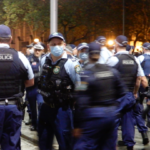Sydney Police Constable Charged After Allegedly Threatening Junior Officers

A Sydney police officer is facing criminal charges after allegedly threatening two ‘rookies’.
The 29-year old police constable has been charged with four offences: common assault, intimidation, causing danger with firearm, and neglect of duty, after an internal investigation found that he improperly used his firearm and threatened two probationary constables at Day Street Police Station in the Sydney CBD.
Police have not released the name of the officer or details of the circumstances in which the charges arose, stating only that:
“A police officer has been charged following investigations into an incident in Sydney earlier this year.
Officers from Sydney City Police Area Command commenced an investigation after two probationary constables were allegedly threatened by another officer in Day Street on Sunday 29 May 2022.
Following extensive inquiries, investigators issued a Court Attendance Notice to a 29-year-old man about 1.30pm yesterday (Friday 25 November 2022).
The man – a constable attached to a command within the Central Metropolitan Region – was charged with common assault, intimidation, causing danger with firearm, and neglect of duty.
He is due to appear at Downing Centre Local Court on Wednesday 18 January 2023
The officer’s employment status is under review.”
Toxic culture
While the fact the internal investigation resulted in criminal charges in this case, it is concerning that such conduct may be occurring in the police force at all.
Indeed, the New South Wales Police Force has long been accused of having a toxic internal culture of bullying, harassment, misconduct, fear of reporting misconduct, internal cover-ups, reprisals for officers who speak out, as well as factions within the force.
In Queensland
The Queensland Government has recently had to confront the serious issues within its own force as a result of the Commission of Inquiry into QPS responses to domestic and family violence which uncovered a myriad of systemic issues. After reading the final report, Premier Annastacia Palaszczuk described the findings as ‘raw and confronting’, as she pledged $100m from her government to initiate change.
The New South Wales Government, however, seems to want to continue to bury its head in the sand over the actions of some of its police officers despite the increasing number of reports of misconduct, in particular towards members of the general public, but internally too, along with a steady stream of criticism about the complaints review process which essentially means police officers investigate themselves.
The charges
The latest incident has resulted in the officer facing the following charges:
Common assault
Common assault in New South Wales does not need to involve physical violence – a person can be found guilty of common assault for causing another to be place in immediate fear for his or her physical safety.
It is an offence under section 61 of the Crimes Act 1900 which carries a maximum penalty of two years imprisonment and/or a fine of 50 penalty units.
One penalty unit is currently equivalent to $110, meaning the maximum fine is $5,500.
To establish the offence, it is enough for the prosecution to prove beyond reasonable doubt that the complainant was in imminent fear for their physical safety, An example of this is where one person raises their hand or fist to another person with aggression without actually making contact with the other person, without the other person having consented to this.
Of course, physical acts of violence, such as slapping, pushing, kicking, spitting, restraining someone can also amount common assault.
Stalking or intimidation
Stalking or intimidation is an offence under section 13 of the Crimes (Domestic and Personal Violence) Act 2007. The offence is described as occurring when a person stalks or intimidates another with the intention of causing the other person physical or mental harm. In New South wales a person can also be charged for ‘attempted’ intimidation or stalking and the same penalties apply as if the offence were actually committed.
The maximum penalty is five years imprisonment and/or a fine of 50 penalty units.
Causing danger with a firearm
Causing danger with a firearm or spear gun is an offence under section 93G of the Crimes Act 1900, which carries a maximum penalty of 10 years in prison.
To establish the offence, the prosecution must prove beyond reasonable doubt that the defendant:
- Possessed a loaded firearm or loaded spear gun, and
- Possessed it in a public place or in any other place so as to endanger the life of any other person, or fired the firearm or spear gun in or near a public place, or carried or fired the firearm or spear gun in a manner likely to injure, or endanger the safety of any person or property, or with disregard for the safety of any person person.
A ‘public place’ includes any place that is publicly owned as well as privately owned property that is open to members of the public, such as restaurants, pubs, clubs, shopping centres, shops, sporting venues and cinemas.
A ‘firearm’ is defined as a gun, or other weapon, that is or was, capable of propelling a projectile by means of an explosive, and includes a blank fire firearm, or an air gun, but does not include a paintball marker.
The definition includes an ‘imitation firearm’, which is an object that, regardless of its colour, weight or composition, or the presence or absence of any moveable parts, substantially duplicates a firearm in appearance, but is not a firearm.
The definition does not include an object produced and identified as a children’s toy.
A firearm is considered to be ‘loaded’ if there is ammunition in its chamber or barrel, or in its magazine or other device capable of fitting ammunition to its chamber or barrel.
A spear gun is ‘loaded’ if a spear, or other instrument or thing similar to a spear, is fitted to it.
You are not guilty of the offence if you are able to satisfy the court, ‘on the balance of probabilities’, that you had a reasonable excuse or lawful purpose for possessing the item.
Neglect of duty
Neglect of duty is an offence under section 201 of the Police Act NSW 1900, which provides that “police officer who neglects or refuses to obey any lawful order or carry out any lawful duty as a police officer is guilty of an offence.”
The maximum penalty for the offence is 20 penalty units.
Defences to the charges
For each of the above offences, a person will be entitled to an acquittal (in other words, a verdict of not guilty) is he or she is able to raise evidence of a legal defence, and the prosecution then fails to disprove the applicability of that defence beyond a reasonable doubt.
Legal defences to the charges include self-defence, duress and necessity.








